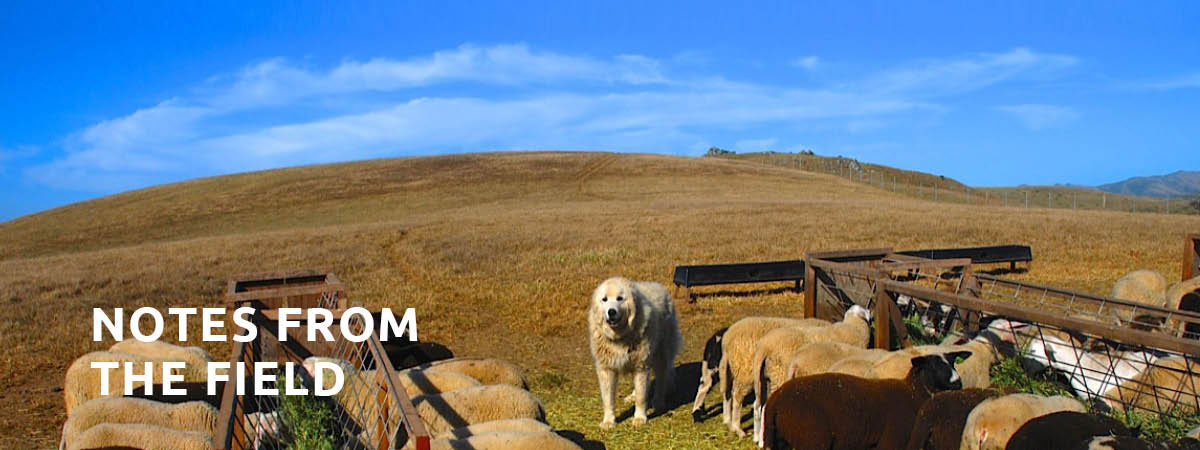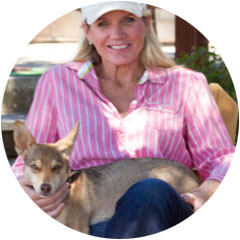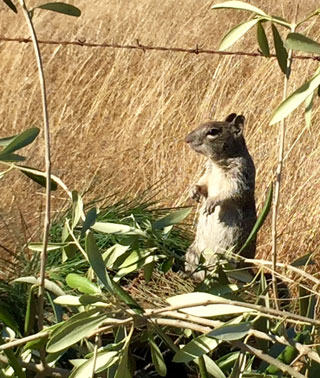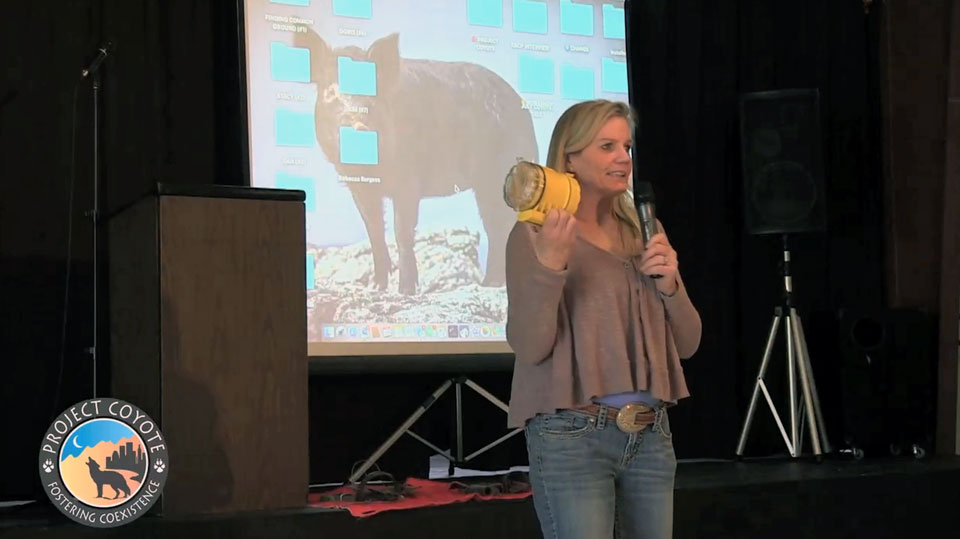A Workshop for Ranching and Wildlife
In March of 2016 Project Coyote, Fibershed and the County of Marin co-sponsored a workshop designed to share wisdom and build knowledge around non-lethal approaches to protecting livestock from predators. Nearly 100 people turned out for this day-long event that covered topics ranging from innovative new predator deterrents such as Foxlights and E-Collars to sustaining traditional practices like livestock guard animals and proper fencing. Presenters offered information on the biological rationale for choosing non-lethal methods, field research findings, wildlife rescue reports, and first-hand experiences from ranchers.
Project Coyote’s Ranching with Wildlife Coordinator Keli Hendricks organized the event, which took place in Petaluma, California at her family’s Rockin’ H Ranch. We hope you’ll enjoy the Workshop Q&A with Keli below, and Project Coyote is pleased to offer the workshop presentations as well as an interview with Anatolian guard dog trainer Nick Cavanaugh, now in their new online home as a resource for all who were not able to attend.
With the success of this first workshop Project Coyote is looking forward to offering more expertise, information, and hands-on trainings through its Ranching with Wildlife Program in 2017 – and as Keli says in her interview, “The public both wants and needs more access to non-lethal workshops and we are hoping to see many more spring up across the country in the future.”
Q&A With Keli Hendricks
Keli, you are the Ranching With Wildlife Coordinator at Project Coyote. What does that entail, and what is your background in this area?
As Project Coyote’s Ranching with Wildlife Coordinator I help ranchers and hobby farmers select the best non-lethal livestock protection tools based on their individual operations. I help plan and organize events like the non-lethal livestock protection workshop, and I give talks to help educate the public about coyote behavior and share effective coexistence strategies. I give interviews to the press and write letters to the editors in an effort to combat some of the fear mongering the media spreads about predators. I also advocate for wildlife at California Fish and Game Commission meetings and I am participating in the Predator Policy Working Group which was formed to modernize predator management policies and regulations in California.
Finally, I also do some miscellaneous tasks like run Project Coyote’s Twitter page.
In terms of background, my uncles were ranchers in Idaho and I have always loved the ranching lifestyle. I knew since I was very young that my career would involve horses and ranching. I went to Cal Poly, San Luis Obispo, where I majored in Animal Science, and after college I became a professional cutting, reining and cow horse trainer. When I first started my career I worked on different ranches and saw how different operations managed livestock around wildlife. I saw how good husbandry practices reduced the number of conflicts with wildlife, and I saw how the opposite was true as well.
The most important lesson I learned was that being a good rancher means more than just caring for your livestock. It means being a responsible steward of the land by respecting the wild animals that were here first and appreciating the benefits they provide to ranch lands.
My husband and I live on a cattle ranch where he has run the cow-calf operation for over 20 years. We have never killed a predator despite having coyotes packs living in the same pastures where our cows calve. We share the land with the native wildlife and have found that we benefit from this arrangement just as much as the wild animals do.
One example of this is while some ranchers consider ground squirrels a pest, we have discovered that they keep our pastures healthier. Their burrows aerate the soil, spread grass seeds and help make pastures more resistant to drought. Their burrows also provide habitat for many other species including burrowing owls.
Another thing that has given me a lot of insight into ranching successfully with wildlife is volunteering at Sonoma County Wildlife Rescue. I foster orphaned wildlife and also work in the wildlife hospital. Working hands-on with coyotes and other wildlife has given me a much better understanding of their behaviors and how to successfully share the land with them.
Could you describe the typical lethal control methods deployed to protect livestock, and contrast with the alternate non-lethal deterrents?
In California, leghold traps and poisons to kill predators have been outlawed (through a public ballot measure passed by voters in 1998), however, neck snares and shooting are both widely used to kill coyotes and other predators. USDA Wildlife Services kills hundreds of thousands of coyotes across the US every year on behalf of the livestock industry, and the methods they use range from traps to aerial gunning to gassing pups in dens.
Unfortunately many lethal tools are indiscriminate killers and far too often pets, endangered species and other non-target animals are killed. Lethal control methods are also considered to be reactive tools, because they are generally used after livestock has already been killed. Non-lethal methods are proactive because they can prevent livestock from being killed in the first place. To me this seems like the most ideal outcome to achieve for animals on both sides of the fence.
Some of the non-lethal techniques discussed at the workshop included Foxlights, Fladry, E-Collars and livestock guard animals. You can learn all about those on our website and in the workshop presentations.
What are some of the challenges you see when it comes to making nonlethal predator control techniques more mainstream?
By far the biggest challenge remains getting people to open their minds to the notion that non-lethal livestock protection methods can and do work. The second hurdle is educating people on how to successfully implement a non-lethal program on their operation. Once minds are open and the information is readily available, the rest will take care of itself.
Can you talk a little more about the history and impact of Wildlife Services?
Wildlife Services has been killing predators on behalf of the ranching industry with taxpayers dollars since 1914. According to their own reports, they have slaughtered over 34 million animals in the last decade alone. Despite exhaustive attempts by conservationists, concerned citizens, politicians and animal welfare groups to get the department to progress past their “kill first” mentality, they continue to waste millions of taxpayers dollars killing native predators. In fact, the amount spent killing predators far exceeds the amount that predators cause in damages.
Even more frustrating is the fact that Wildlife Services continues this slaughter year after year without having to prove whether all this killing helps keep livestock any safer at all. For those who want to learn more there are articles and information about Wildlife Services on our website as well.
Singling out Foxlight deterrents for a moment, what kind of research is going into determining their effectiveness?
In 2015, Project Coyote placed Foxlights on four different sheep operations in Marin and Sonoma County during the lambing season. None of the ranchers had a confirmed loss from predators during that lambing season and every rancher purchased the lights after the test period was over. It wasn’t a scientific study but the anecdotal evidence was very positive. Hopland Research and Extension Center is also working with Project Coyote and testing Foxlights on their sheep operation this year. Foxlights are being used by more and more wildlife agencies across the US to protect livestock from wolves, coyotes, grizzlies and more. They have also been being used in Africa to protect livestock from predators and crops from elephants. Recently Foxlights were used successfully to repel wildlife from an area that had experienced an oil spill.
There are also other new technologies that we are really excited about. Project Coyote recently purchased some of the first E Collars to be shipped to the U.S. E Collars have been used to protect sheep in Africa from predators. A collar is placed on 1 out of every 10 sheep, and if the flock is chased by a predator the collars emit an alarm and flashing lights which disrupt the attack. We are excited to get these E Collars out in the field for testing.
In 2016 Project Coyote hosted the first Ranching With Wildlife Workshop at your family’s ranch in Petaluma. Could you describe the purpose of the workshop, who attended, and the outcome?
The purpose of the workshop was to share information with ranchers about different non-lethal tools, how to use them, why they work, and what non-lethal tools work best for which situations.
Livestock protection workshops offered across the country have historically focused only on lethal control methods. In my mind this is teaching people how to shut a barn door after the horse has ran out. It makes far more sense to teach methods to help prevent conflicts from occurring in the first place, and that’s how the idea for our non lethal workshop originated.
Our workshop had 11 speakers including an Anatolian Shepherd breeder, predator friendly ranchers, the Marin County Agricultural Commissioner, and more. Many different stakeholders were in attendance including ranchers, hobby farmers, conservationists, a wildlife rescuer and even a county trapper.
We received a lot of positive feedback about the workshop, and it’s obvious that attitudes towards our treatment of wildlife are beginning to change. The public both wants and needs more access to non-lethal workshops and we are hoping to see many more spring up across the country in the future.
Is another workshop planned, and if so, when, where, and what should people know about it?
We are looking into doing another co-sponsored workshop in Northern California. We are also working on a film about the Marin Livestock & Wildlife Protection Program to help share this successful model with other communities across North America. If you are interested in receiving a notification regarding future workshop dates, please sign up here.
Learn more by exploring Project Coyote’s Ranching With Wildlife Program




